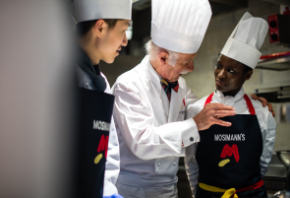- About
- Programs
- Campus Life
- Career Services
- Admissions
- News & Events
- Alumni
Difference Between Vegan and Vegetarian: Benefits & Risks
Discover the key differences between vegan and vegetarian diets, their benefits, and challenges. Choose the right diet for you and start your journey today!
Key Takeaways
- Both vegan and vegetarian diets focus on plant-based foods and avoid meat.
- They differ in how strictly they exclude animal products—vegans avoid all, while vegetarians may include dairy, eggs, or fish.
- Both diets can offer health benefits like improved heart health, better weight management, and lower cholesterol.
According to the World Health Organization (WHO), around 60% of the factors that influence an individual's health and quality of life are linked to lifestyle choices. With this in mind, many people actively seek ways to improve their well-being, often by adopting new habits and adjusting their diets.
While some focus solely on personal health, others extend their choices to consider the well-being of animals and the planet at large. Global food production issues, such as transportation, pesticide and antibiotic use, and GMO foods, are concerns that also directly or indirectly affect general health.
Two prominent dietary lifestyles that reflect these values are veganism and vegetarianism. Although they might seem similar at first, the key difference lies in their specific approaches and dietary boundaries.
Key Differences Between Vegan and Vegetarian Diets
Both vegan and vegetarian diets avoid meat and instead focus on plant-based foods. However, the difference between the two becomes clear when examining their dietary rules, ways of fulfilling nutritional needs, as well as personal values related to animals and the planet.
Dietary restrictions
Vegans follow a more restrictive path. In addition to meat and fish, they avoid all animal products, including dairy, eggs, honey, and more. In fact, for them, reading ingredient lists becomes second nature, as animal-derived substances can sneak into processed foods in surprising ways. For example, gelatin (found in many candies) comes from animals, while casein, a protein derived from milk, is commonly used in processed foods and protein powders.
Vegetarians often adopt this diet style for health, taste, or food tolerance reasons, though animal welfare is often still a deciding factor. Their exact boundaries vary a lot, as there are many subgroups of vegetarianism with different preferences. Some of these types include:
- Lacto-vegetarians: Eat dairy but not eggs.
- Ovo-vegetarians: Eat eggs but not dairy.
- Lacto-ovo vegetarians: Eat both dairy and eggs but avoid meat and fish.
- Pescatarians: Avoid meat and poultry but eat fish and seafood.
- Flexitarian: Follow a mostly plant-based diet but occasionally include meat, fish, or poultry.
Nutritional considerations
While meat is a well-known source of protein, both vegan and vegetarian diets can be nutritionally complete when properly planned.
A healthy vegan diet starts with plenty of fruits and vegetables—at least five portions daily—along with starchy foods like wholegrain bread, rice, and pasta. Plant-based alternatives, such as soy drinks and dairy-free yogurts, also help provide calcium and other essential nutrients.
The protein gap left by avoiding meat is filled with plant-based staples such as beans, lentils, tofu, tempeh, seitan, and pulses. However, unlike animal proteins, most plant-based proteins are incomplete, meaning they lack one or more essential amino acids. It's important to combine complementary plant-based proteins to ensure a complete protein intake. For example:
- Legumes and grains: Beans and rice, lentils and barley, or peas and rice create a complete protein by balancing amino acid profiles.
- Nuts and seeds with legumes: Combining chickpeas with tahini (as in hummus) or peanut butter with wholegrain bread also provides all essential amino acids.
However, additional nutrients require careful attention. Some of the most important include:
- Calcium and vitamin D: Obtained through leafy greens, calcium-set tofu, fortified plant milk, and safe sun exposure or supplements.
- Iron: Found in pulses, whole grains, leafy greens, and dried fruits.
- Vitamin B12: Sourced through fortified products like nutritional yeast, plant-based drinks, or supplements.
- Omega-3 fatty acids: Found in plant oils (such as rapeseed and flaxseed) as well as nuts and seeds.
Maintaining hydration and practicing moderation with sugars and saturated fats are essential for a well-balanced vegan diet.
For vegetarians, the starting point is similar: fruits, vegetables, whole grains, and legumes form the core of their diet. However, the inclusion of dairy and eggs makes meeting certain nutritional needs more straightforward. These foods naturally contribute protein, calcium, and vitamin B12, reducing the reliance on fortified products.
Still, vegetarians pay attention to the following key nutrients:
- Iron and zinc: Found in legumes, whole grains, and leafy greens; best absorbed when paired with vitamin C-rich foods like citrus or peppers.
- Omega-3 fatty acids: Sourced from walnuts, flaxseeds, chia seeds, and rapeseed oil.
- Vitamin D and calcium: Easily obtained from dairy but should also be supported with leafy greens, fortified cereals, and plant-based drinks.
And just as for vegans, hydration, fiber intake, and moderation with added sugars and saturated fats are important parts of maintaining overall balance and well-being.
Ethical and environmental aspects
For vegans, the commitment extends beyond diet to reducing harm to animals in all aspects of life. This includes all aspects of life, including clothing, furnishings, and cosmetics, avoiding leather, wool, silk, and products tested on animals. Many also adopt veganism for environmental reasons and to eliminate animal exploitation.
Vegetarians primarily focus on dietary choices. Their reasons for avoiding meat may vary—some do so for health, while others aim to prevent animal slaughter but feel comfortable consuming dairy or eggs, especially when sourced from what they consider humane producers.
The environmental impact also differs between the two diets. A vegan diet generally has a lower carbon footprint, as it eliminates animal agriculture, one of the largest contributors to greenhouse gas emissions. A vegetarian diet still relies on dairy and egg farming, which have their own environmental impact but remain more environmentally friendly than meat-heavy diets.
Pros and Cons of a Vegan Diet
Like any lifestyle choice, a vegan diet comes with its strengths and its challenges. While it offers undeniable benefits, mindful planning is essential to avoid potential nutritional gaps.
Benefits
Considering how many people choose veganism, the health advantages play a big part in its appeal. Key benefits include:
- High in fiber, antioxidants, and essential vitamins from fruits, vegetables, and legumes.
- Supports heart health by reducing cardiovascular disease, high blood pressure, and cholesterol levels.
- Aids weight management due to lower calorie density and high fiber intake, which promotes satiety.
Challenges
Following this diet also presents certain difficulties—and it may not be suitable for everyone. Key challenges include:
- Potential nutrient deficiencies if the diet isn't properly planned or balanced.
- Limited vegan options when eating out or traveling, making it harder to maintain consistency.
- Higher costs for specialty products like vegan meats and cheeses
Pros and Cons of a Vegetarian Diet
Similarly, a vegetarian diet has its own pros and cons.
Benefits
As with the vegan diet, health is a major advantage of a vegetarian diet. Some key benefits include:
- High intake of fruits, vegetables, whole grains, and legumes, supporting digestive health and gut balance.
- Lower cholesterol levels and a reduced risk of chronic illnesses.
- Easier nutrient intake for calcium, vitamin B12, and protein through dairy and eggs, reducing the need for fortified foods or supplements.
Challenges
Despite being less restrictive than a vegan diet, vegetarianism still presents certain obstacles, including:
- Potential nutrient deficiencies if dietary variety is lacking.
- Overreliance on dairy and processed vegetarian foods, which can lead to excessive saturated fat and added sugars.
- Environmental concerns due to the impact of dairy and egg farming.
How to Choose the Right Diet for You
Neither of the two options is universally better than the other. What makes one the right choice for someone is all based on how well it aligns with their health goals, lifestyle, values, and long-term aspirations.
Rather than focusing on which diet seems easier or more restrictive, consider what feels realistic and fulfilling for you.
As you consider both options, you should:
- Assess your motivation and reasoning behind both options, whether it's health, ethics, or environmental impact.
- Consider your flexibility in terms of the restrictions set.
- Look at your current habits and think about whether you're ready to give those up.
- Think long-term and choose the option that feels manageable for the future, not just for a short-term change.
- Consult a professional (like a dietitian) who can help you make sure your choice meets your nutritional needs.
Tips for transitioning to a plant-based diet
Once you make your choice and are ready to transition to veganism or vegetarianism, it's important to go through the following steps:
- Start by gradually eliminating meat or animal products rather than making an abrupt change.
- Experiment with plant-based proteins and dairy alternatives to find what you enjoy most.
- Try a trial period when you commit to a few weeks or a month and see how you feel.
- Learn to read ingredient labels carefully to identify hidden animal-based ingredients.
- Find new recipes and cooking methods to keep your meals exciting and diverse.
- Plan ahead for social situations and eating out so you're never caught without good options.
Turn Your Passion for Plant-Based Cuisine into a Career
Even if a vegan or vegetarian lifestyle isn't something you personally choose, you can still play a role in supporting those who do. For many vegans and vegetarians, finding well-crafted, thoughtful alternatives to traditional dishes can be a challenge—and that's something a skilled chef can make a difference in. By mastering the culinary techniques needed to prepare delicious, balanced, and visually stunning plant-based dishes, you can help fill that gap.
At Culinary Arts Academy Switzerland (CAAS), the Certificate in Vegetarian and Plant-Based Culinary Arts is designed for this purpose. Whether you're a culinary student or an industry professional, this flexible, 11-week program in Le Bouveret helps you add plant-based excellence to your repertoire.
As Alain Müller, Assistant Dean at Culinary Arts Academy, explains:
At Culinary Arts Academy, we've always taken vegetarian and vegan diets into account, in both our practical and theoretical modules.
So whether or not these diets are on your plate, with CAAS, you can still make them part of your skill set.
Frequently Asked Questions
Is a plant-based diet suitable for children and teenagers?
Certainly—as long as the diet is balanced and thoughtfully planned and the child or teenager eats enough to support their growth.
What are the best plant-based meat substitutes for beginners?
Some great substitutes for beginners include tofu, tempeh, seitan, or lentils. They're easy to use, super versatile, and fit nicely into various meals.
Interested in studying at CAAS? Download our brochure to learn about our programs!

























